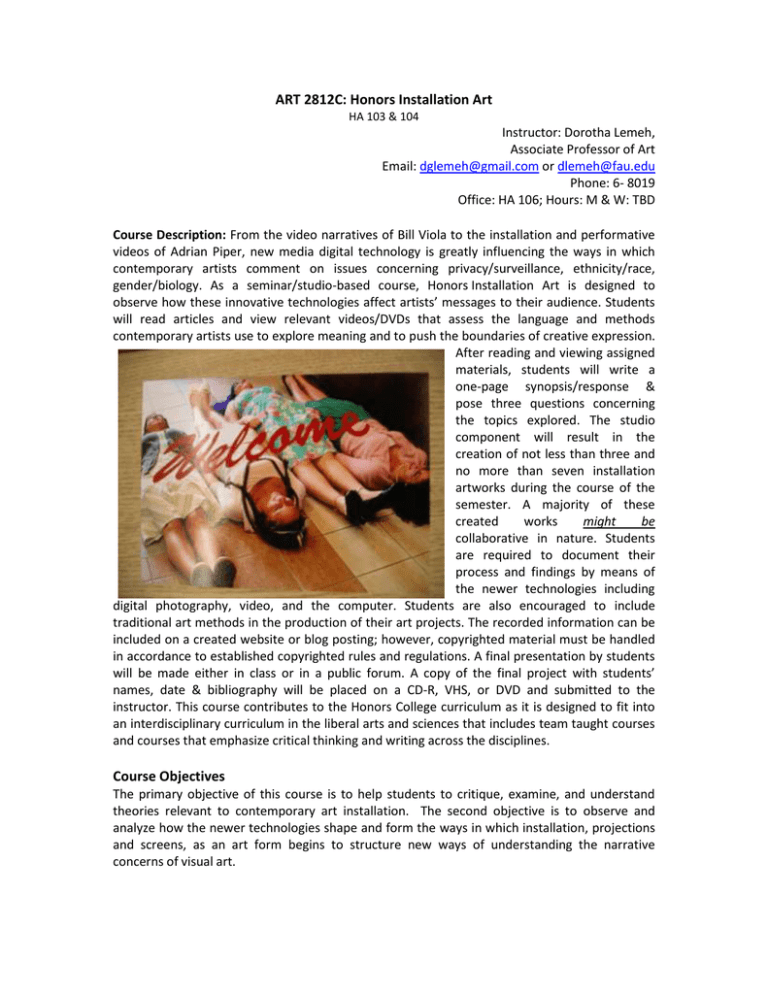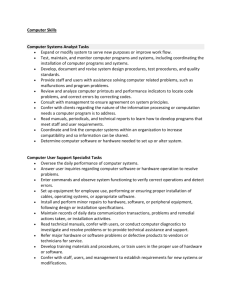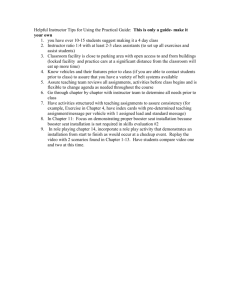syllabus
advertisement

ART 2812C: Honors Installation Art HA 103 & 104 Instructor: Dorotha Lemeh, Associate Professor of Art Email: dglemeh@gmail.com or dlemeh@fau.edu Phone: 6- 8019 Office: HA 106; Hours: M & W: TBD Course Description: From the video narratives of Bill Viola to the installation and performative videos of Adrian Piper, new media digital technology is greatly influencing the ways in which contemporary artists comment on issues concerning privacy/surveillance, ethnicity/race, gender/biology. As a seminar/studio-based course, Honors Installation Art is designed to observe how these innovative technologies affect artists’ messages to their audience. Students will read articles and view relevant videos/DVDs that assess the language and methods contemporary artists use to explore meaning and to push the boundaries of creative expression. After reading and viewing assigned materials, students will write a one-page synopsis/response & pose three questions concerning the topics explored. The studio component will result in the creation of not less than three and no more than seven installation artworks during the course of the semester. A majority of these created works might be collaborative in nature. Students are required to document their process and findings by means of the newer technologies including digital photography, video, and the computer. Students are also encouraged to include traditional art methods in the production of their art projects. The recorded information can be included on a created website or blog posting; however, copyrighted material must be handled in accordance to established copyrighted rules and regulations. A final presentation by students will be made either in class or in a public forum. A copy of the final project with students’ names, date & bibliography will be placed on a CD-R, VHS, or DVD and submitted to the instructor. This course contributes to the Honors College curriculum as it is designed to fit into an interdisciplinary curriculum in the liberal arts and sciences that includes team taught courses and courses that emphasize critical thinking and writing across the disciplines. Course Objectives The primary objective of this course is to help students to critique, examine, and understand theories relevant to contemporary art installation. The second objective is to observe and analyze how the newer technologies shape and form the ways in which installation, projections and screens, as an art form begins to structure new ways of understanding the narrative concerns of visual art. ART 2812C Professor Dorotha Lemeh 2 Additional Requirements of this course Students may be asked to attend art exhibitions, film screenings, plays or some other art related activity at various on- or off-campus venues. Required Texts: Bishop, Claire (2010) Installation Art. London: Tate Kaye, Nick (2007) Multimedia: Video Installation – Performance. Routlegde Mondoch, Kate (2010) Screens: Viewing Media Installation Art. MN: University of Minnesota Press Method of Evaluation of Student Assignments Grade Assessment Class attendance and participation is mandatory. 10% is subtracted from the overall grade for lack of participation & attendance problems. Visual Projects 50% Written Component 50% Written Component 2 Discussion papers 50 points each paper (Possible 100 points) 10 Blog Entries 20 points each entry (Possible 200 points) Discussion Papers Discussion papers (300 to 500 words) are evaluated on the basis of the student’s ability to analyze, evaluate, and provide insight on subjects discussed. Grammar, spelling, and other forms of writing mechanics will also be considered. On-line resources for writing can be located at this site: www.mla.org At the top of each discussion paper include the following: Student’s name & the date Title of the course, course number, and instructor’s name Title of the reading and name of the author Word Count Note: When you email items be sure to place the course & assignment topic in the heading of the email. BLOG Postings The Blog entries are more of a conversation about the lectures/presentations as well as the readings, rather than a formal paper. The Blog/Vodcast is a space for extending the dialogue that originated from the class discussion. Students are able to include video or podcast, graphic illustrations, writing and digital images relating to the AHS seminar. By the end of the course students will have amassed an impressive eportfolio of responses and images used to expand the discussion that is taking place in the seminar. A CD/DVD of the blog postings is to be submitted to the instructors at the conclusion of the course. Word count for each entry: 200 – 400. Note: Pod- and/or vodcast can (and are encouraged to) accompany Blog postings. EXAMPLE BLOG LAYOUT Date: Name: Class: Instructor: ART 2812C Professor Dorotha Lemeh 3 Word Count: _______________ Pod- or Vod-cast: _____Yes or ____No Blog Entry # ____ Author/Artist: ____________________________________________________ Title of Reading Assignment & Art: Discussion: Attendance and Class Participation Regular attendance is not only expected, it is graded. All students are required to come to class, be on time, and have assignments completed. The student is solely responsible for material covered during his/her absence & therefore, it remains the student’s responsibility to consult with the instructor in person for information about missed assignments. Every absence after 3 will result in the lowering of the overall grade by10%. 4 absences = highest grade is a B+ 5 absences = highest grade is a C+ 6 absences = highest grade is a D 7 absences = automatic failure Class participation means coming to class having completed the assignments. It also means being prepared to ask and answer questions on the artworks viewed and the artists read or discussed. It also may mean working in small groups during these discussions. Since this class is viewed as discussion-based, individual participation is looked on as a vital component of student learning and engagement and therefore is graded. Lack of class participation will result in the lowering of your grade by 10%. Code of Academic Integrity policy statement Students at Florida Atlantic University are expected to maintain the highest ethical standards. Academic dishonesty is considered a serious breach of these ethical standards, because it interferes with the university mission to provide a high quality education in which no student enjoys an unfair advantage over any other. Academic dishonesty is also destructive of the university community, which is grounded in a system of mutual trust and places high value on personal integrity and individual responsibility. Harsh penalties are associated with academic dishonesty. For more information, see University Regulation 4.001. For information regarding the Honor Code, see: http://www.fau.edu/divdept/honcol/academics_honor_code.htm Students with Special Needs The rights of students with disabilities are protected under Section 504 of the Rehabilitation Act of 1973 (Section 504) and the Americans with Disabilities Act of 1990 (ADA). Please consult the University website for additional information concerning Disability Services: http://www.osd.fau.edu . In compliance with the Americans with Disabilities Act (ADA), students who require reasonable accommodations due to a disability to properly execute coursework must register with the Office for Students with Disabilities (OSD) -- in Boca Raton, SU 133 (561-297-3880); in Davie, LA 240 (954-236-1222); or in Jupiter, SR 110 (561-7998010) – and follow all OSD procedures. Any student with a documented disability or special need, who requires reasonable accommodations for assignments will need to contact Disability Services Office at the beginning of the semester. Cheating and Plagiarism: Don’t! You are here to learn to think for yourself. Give yourself the opportunity to express your own unique point of view. I know it is tempting to use Wikipedia as your primary source of information, but might I suggest other valuable sources, such as, the reading material provided, Jstor [ http://www.jstor.org], ART 2812C Professor Dorotha Lemeh 4 Oxford Journals [ http://www.oxfordjournals.org] , Oxford Art Journal [http://oaj.oxfordjournals.org], or the Journal of Fine Art and Studio [http://www.academicjournals.org/JFSA/index.htm]. Note of Honors Distinction: This course differs substantially from the non-Honors version. First, the writing component of the course will be much more demanding, and will prepare students for upperdivision college writing and for work on the Honors Thesis. Students will be exposed to vocabulary of a specifically theoretical nature, and will be expected to comprehend these new concepts and to deploy these new terms in their own critical thinking and writing. In addition, we will begin professionalizing our own readings and analyses of these texts. Students will be expected to familiarize themselves with the history and the ongoing critical and scholarly conversation about these works, and will give in-class presentations about critical history and about the living scholars in the field as it now stands. Students will also engage with the theoretical tools used by today’s reading community to study literature. Most importantly, this course will reflect the interdisciplinary nature of Honors education and will inculcate critical attitudes and skills that will teach you how to learn for yourself. Class Room Etiquette Reframe from disruptive behavior in class, and please be respectful of your classmates’ point of view. We are all here to learn, and as such, we need to find ways in which to honor our fellow classmates perspectives that may be different than our own. Please no eating in class. Digital and Electronics in the Classroom Students are encouraged to bring laptops, ipads, Kindles, and other electronic devices to class for the sole purpose of taking notes and actively participating in the exchange-taking place in the AHS seminar. This is a time for working towards completing class assignments and not viewing your email, texting, watching on-line videos, checking facebook or any other form of non-academic activity. Abuse of such a privilege may lead to banning these items from the classroom. University policy on the use of electronic devices states: “In order to enhance and maintain a productive atmosphere for education, personal communication devices, such as cellular telephones and pagers, are to be disabled in class sessions.” Policy on makeup exams/quizzes, papers and handing in late work Assignments not completed due to missed classes: Work not completed due to missed classes, tardiness, or ineffective use of time has to be made up outside of class. Turning in Late Assignments: At times a student may have unforeseen events impact on the handing in of her or his work by the assigned due date. A student can request an extension, however, the extension (depending on the reason) may or may not be granted. Such an extension will be decided on a case-by-case basis and is subject to the instructors’ approval of such an action. Though numerous reasons for an assignment‘s incompletion exists 20% will be subtracted from the final grade for class assignments or homework that has not been granted an extension and/or submitted a day after it is due. After one week 30% will be subtracted from the final grade. Weekly Schedule Potential Project Themes 1. 2. 3. 4. Obsessed with Blending In Beyond the Box VisUal Surveillance: Private Lives & Public Spaces Time, Space & the 4th Dimension ART 2812C Professor Dorotha Lemeh 5 5. Quota (The Movie) 6. Body Tourism 7. The Self Week 1: Welcome. Presentation/ lecture on Installation Art - origins Day 1: Read: Chapters 1 & 2 in Mondoch’s Screens: Viewing Media Installation Art Class Discussion: Break into small groups in order to discuss the readings. Day 2: Read: Nakamura, Linda (1998) "Where Do You Want to Go Today? Cybernetic Tourism, The Internet, and Transnationality" in The Visual Culture Reader. Nicholas Mizeroff, (ed.) New York: Routledge., pgs. 255-263. Class Discussion: Break into small groups in order to discuss the readings. Week 2: Lecture/Presentation on Installation Art - contemporary Viewing DVD includes analysis of visual elements and application of those elements in studio work. Furthermore, perspectives of different artists are to be analyzed and constructed into individual works. Studio: 3-D Design Hybrid (Body & Form) Project. 1st installation art projection/video Blog Posting: Write a one-page synopsis with questions on each reading provided. Class Discussion: Break into small groups in order to discuss the readings. Homework: Assigned Reading: Joyce, Michael (1999) "On Boundfulness: The Space of Hypertext Bodies" in Virtual Geographies: Bodies, Space, and Relations. Mike Crang, Phil Crang, and Jon May, (eds.) New York: Routledge, pgs. 222-243. Weeks 3 & 4: Lecture/Presentation Studio: Design and develop 2nd installation art piece Blog Posting: Write a one-page synopsis with questions on each reading provided. Class Discussion: Break into small groups in order to discuss the readings. Assigned Reading: Chapters 3 & 4 in Mondoch’s Screens: Viewing Media Installation Art Week 5 Studio: Design and develop 3rd installation art piece Blog Posting: Write a one-page synopsis with questions on each reading provided. Class Discussion: Break into small groups in order to discuss the readings. Assigned Reading: Weeks 6 & 7: Midterm Art Piece Studio: Design and develop 4th installation art piece Create Art Work using digital or computer-aided technology. Critique. Weeks 8 & 9: Studio: Design and develop 5th installation art piece Blog Posting: Write a one-page synopsis with questions on each reading provided. Class Discussion: Break into small groups in order to discuss the readings. Assigned Readings: Hammonds, Evelynn. (1997) "New Technologies of Race" in Processed Lives: Gender and Technology in Everyday Life. Jennifer Terry and Melodie Calvert, (eds.) New York: ART 2812C Professor Dorotha Lemeh 6 Routledge, pgs. 108 – 121; Chapters 1, 2 & 3 in Kaye’s Multimedia: Video Installation – Performance Weeks 10 & 11: Studio: Design and develop 6th installation art piece Blog Posting: Write a one-page synopsis with questions on each reading provided. Class Discussion: Break into small groups in order to discuss the readings. Assigned Reading: Chapters 1, 2 & 3 in Bishop’s Installation Art Weeks 12 & 13: Lecture/Presentation. Studio: Design and develop 7th installation art piece Create artwork using digital or computer-aided technology. Blog Posting: Write a one-page synopsis with questions on each reading provided. Class Discussion: Break into small groups in order to discuss the readings. Assigned Readings: Bordowitz, Gregg. (1997) "Present Tense" in Processed Lives: Gender and Technology in Everyday Life. Jennifer Terry and Melodie Calvert, (eds.) New York: Routledge, pgs. 104 - 105. High Kathy. (1997) "Taylor's Way: Women, Cultures and Technology" in Processed Lives: Gender and Technology in Everyday Life. Jennifer Terry and Melodie Calvert, (eds.) New York: Routledge, pgs. 82 - 92. Weeks 14 & 15: Individual Critiques Week 16: Discussion Materials List In order to keep the cost down, as much as possible, we will work with available materials. Sometimes experimentation and creative risk-taking might involve requiring materials that will need ot be purchased by the student. The following items can be purchased locally at Jerry’s Artarama or Micheal’s. If you prefer to order on-line these art materials can be obtained through Dick Blick, Pearl Paint, Amazon or Jerry’s. The digital equipment can be purchased at Best Buy. Journal (50 to 100 pages) and drawing instruments 3-Ring Binder Digital camera with tripod. (Extremely useful, though not required.) 16G or 32G Memory Stick/flash drive or Portable external Hard Drive (up to 1 TB USB 3.0) Box of CD/DVD discs Selected Bibliography Grau, Oliver. (2007) Media Art Histories. Cambridge, MA: MIT Press. Green, Eileen. (2001) Virtual Gender: Technology, Consumption and Identity Matters, New York: Routledge. ART 2812C Professor Dorotha Lemeh 7 Gombrich, E. H. (1961) Art and Illusion: A Study in the Psychology of Pictorial Representation. Princeton, NJ: Princeton University Press Hopkins, Partick. (1999) Sex/Machine: Readings in Culture, Gender, and Technology (Indiana Series in the Philosophy of Technology) Indiana University Press Kwon, Miwon (2004) One Place after Another: Site-Specific Art and Locational Identity. MIT Press Lerman, Nina, Arwen Ruth, P. Mohun. (2003) Gender and Technology: A Reader. The Johns Hopkins University Press. Oldenziel, Ruth. (2004) Making Technology Masculine: Men, Women, and Modern Machines in America, 1870-1945, Amsterdam University Press,. Oliveria de Nicholas and Nicola Oxley. (2004) Installation Art in the New Millennium: The Empire of the Senses. Thames and Hudson Popper, Frank. (2007) From Technology to Virtual Art. Cambridge, MA: MIT Press. Preble, Duane, and Sarah Preble. (1993) Artforms: An Introduction to the Visual Arts, 5th ed. New York: HarperCollins Priebe, Ken A. (2006) The Art of Stop-Motion Animation. Boston, MA: Course Technology PTR. Rodarmor, William. (2005) Creating Photomontages with Photoshop: A Designer’s Notebook. Cambridge, MA: Oreilly Media, Inc. Press. Rosenthal, Mark (2003) Understanding Installation Art. Prestel Publishing Terry, Jennifer. (1997) Processed Lives; Gender and Technology in Everyday Life. New York: Routledge. Wands, Bruce (2007) Art of the Digital Age. New York, NY: Thames & Hudson. Wosk, Julie. (2003) Women and the Machine: Representations from the Spinning Wheel to the Electronic Age, The Johns Hopkins University Press



